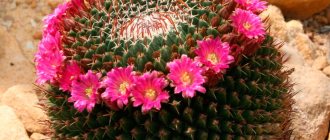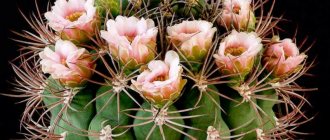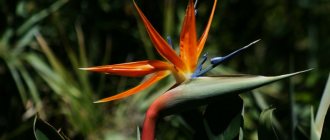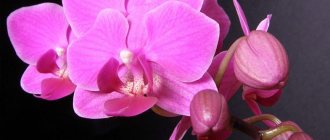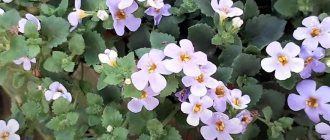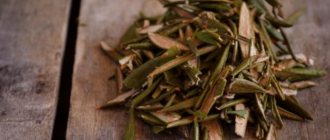In its wild form, fuchsia is a perennial evergreen shrub or small tree that grows in nutritious soils of forest edges and wet mountain crevices. The birthplace of flowers, botanically called Fuchsia (lat.), is Latin America and New Zealand. In their modern form, fuchsias are grown in unprotected soil in countries characterized by mild winters and cool summers. In a temperate climate, it is unrealistic to grow these flowers outdoors, but growing fuchsia in a pot in a garden is quite possible.
How to care?
When growing fuchsia at home, you must follow certain rules and create comfortable conditions that will ensure the plant a long life, enjoying long and lush flowering.
So, how to care for this flower so that it blooms?
We talked in detail about the subtleties and nuances of growing fuchsia and caring for it at home in this article.
Choosing a pot
What size should the pot be? You should not plant fuchsia right away in a large pot. She can't stand too much space, but she can't stand being cramped either. Starting growing from a small shoot, you should choose small dishes, the size of a plastic glass. As the flower grows and its root system expands, it should be transplanted into a looser pot.
REFERENCE! Plastic pots with large drainage holes are best suited for planting fuchsia. Clay pots are also suitable, but when using them, more frequent watering will be required, since the water in them evaporates not only from the surface of the soil, but also through the walls.
Soil composition and proportions
An important criterion when choosing soil for planting fuchsia is the ability to pass air to its root system; it must be sufficiently loose. What land does he like? For fuchsia, a slightly acidic ready-made universal soil with a pH level of no higher than 6.0 is suitable. It should be the same as for indoor plants and contain peat, ash, sand. You can also prepare an earthen mixture yourself, you just need to maintain the following proportions:
- leaf soil, peat, sand (3:2:1);
- turf soil, compost, humus (2:1:1).
To prevent the roots of the plant from rotting, it is necessary to use drainage, which will ensure that there is no stagnation of water. Small pebbles, expanded clay or broken bricks may be suitable for this.
Air humidity
In the room where fuchsia will grow, you need to set the humidity level within 40-60%. During the period of active growth, the plant will require additional moisture. This can be achieved by spraying the leaves with a spray bottle twice a day - morning and evening. At the same time, make sure that the flower is not exposed to direct sunlight, which can lead to burns.
What to do with the flower in autumn and winter (read here about how to preserve fuchsia in the basement and in the apartment in winter, and from this article you will learn whether it is possible to prune a bush for the winter and how to carry out the procedure)? There is definitely no need to spray, but to maintain optimal air humidity, you can use a container of water placed next to the pot.
Lighting and location
The most correct placement of a fuchsia pot will be rooms located on the southwest or east side. Having placed the plant indoors on the south side, it is worth placing the pot not on the windowsill, but on a table or shelf next to the window, thus protecting it from direct sunlight. When placing fuchsia near a window on the north side, you should be prepared for the fact that the plant will bloom weaker and stretch out more. Drafts in fuchsia can cause its leaves and buds to fall off.
Important! During the period of formation, blossoming and flowering of buds, in no case should you rearrange the pot with the bush, this can lead to the fall of all the flowers and buds.
Fuchsia is a light-loving flower, but prefers soft, diffused light. It tolerates morning and evening sun rays without consequences, but it should be protected from the hot rays of the sun during the day by covering the pot or shading the window.
Temperature
Fuchsia is a rather demanding plant regarding air temperature. During the period of active growth and flowering, the plant prefers to be warm; in summer and spring, the optimal comfortable temperature will be 18-25 degrees, but it is very important that the temperature does not exceed 30 degrees, otherwise this can lead to wilting of the leaves and falling off of buds and flowers.
In winter, fuchsia goes into a dormant state; during this period, the comfortable temperature will be 10-12 degrees. In an apartment, a pot with a plant can be placed on an insulated loggia, where the temperature does not drop below 3 degrees.
Watering
Proper and timely watering is the main condition for growing fuchsia. The amount of moisture needed and the frequency of watering depend on the time of year and the condition in which the plant is.
In winter, when fuchsia is at rest, it should be watered no more than 2-3 times a month, provided it is in a cool place. If the flower overwinters at room temperature, then the number of waterings should be increased to 3-4 times a month. With the onset of spring and until autumn, when fuchsia enters the growing season, it needs to be provided with abundant regular watering, while avoiding stagnation of water near the roots, which can lead to their rotting and death of the plant.
Flowering plants have the greatest need for water. When watering fuchsia, you should use warm boiled water, without the presence of chlorine impurities.
Now you know how to preserve fuchsia. It is enough just to create the appropriate conditions for it.
Reproduction
Propagation by cuttings
This type of vegetative propagation of fuchsia is more suitable for beginners. The best time is early spring or late summer.
- The cutting should be harvested from a healthy plant.
- Inspect the fuchsia for yellow leaves, pests in the soil and on the stems. Young stems that have at least several pairs of leaves and a flower bud are suitable.
- Place the shoot, cut at an angle of 45 degrees, in a glass of water and place it in a well-lit place, waiting for the roots to appear.
- Or we immediately plant it in a pot of soil and moisten the soil.
- As it grows, we tear off the leaves on the lower part of the stem. This way, the infection from the ground will not spread to the plant.
Growing fuchsia from seeds
When choosing seeds in a store, pay attention to their expiration date. It should not exceed 3 years. Remember - the fresher the seeds, the better their similarity.
Sown in the ground from late February to April. The ground should be light. It is better to buy a ready-made mixture at a flower shop for these purposes.
Choose a wide pot with low sides for sowing to ensure faster soil warming. Places it in a lighted place. Periodically water and humidify the air. After some time, the seedlings have appeared and become stronger and are transplanted into a pot.
Fertilizers
We'll tell you how to feed fuchsia for abundant flowering.
To achieve lush and beautiful flowering, fuchsia must be regularly supplied with fertilizers during the growing season. What elements should the supplement contain:
- Young plants need fertilizers rich in nitrogen, which promotes rapid growth and a bright green color.
- An adult plant should be fertilized with fertilizers containing potassium and phosphorus, which ensure lush, abundant flowering.
Organic fertilizers are also suitable for fuchsia, but they should still be alternated with mineral ones. Before fertilizing, you need to make sure that the soil in the pot is sufficiently moist. Experienced gardeners advise applying fertilizer every 2 weeks. Otherwise, too much fertilizer can lead to the growth of leaves, but the flowers on it will become rare.
IMPORTANT! In winter, when the plant is dormant, the use of fertilizers should be stopped.
You cannot use fertilizer for the following fuchsias:
- Sick plants.
- Young cuttings whose root system is not yet fully formed.
Varieties
There are currently more than 113 types of fuchsia. In home floriculture, indoor fuchsia is used, which includes several dozen hybrids.
Bright red fuchsia is in demand when creating bright street compositions. It begins to bloom in April and retains inflorescences until the very end of October. The petals are bright red and the center is purple. The variety is cultivated at home and in office complexes.
The Ballerina variety got its name for a reason. It has pinkish-white lush double petals. The inflorescence is small, but impressively framed by pink sepals. From under the “skirt” you can see soft scarlet pistils and stamens. The plant will be a worthy decoration for a home greenhouse.
If you want to not only decorate your windowsill, but also get delicious fruits, the Splendence variety is suitable. It forms elongated scarlet inflorescences with light green petals. They resemble inverted chili peppers in shape and color. These lanterns produce delicious long fruits with a lemon tint. Splendence blooms all year round.
In the southern regions, Magellan fuchsia can be planted directly in open ground. This is a giant variety, adult plants reach 3 meters in height. Even after flowering, the Magellan variety is pleasing to the eye, because its leaves are colored purple and covered with soft fluff. The inflorescences are red-violet, with long, prominent stamens. The plant forms a bush, but the pedicels are ampelous and descend to the ground.
Fact! The variety can winter at temperatures of 5-10 degrees, so in the south it is left in the ground, and in the northern regions it is brought onto the balcony.
It is impossible not to mention sparkling fuchsia. This is an incredibly beautiful plant that produces rich purple flowers. They are framed by pink sepals. The leaves are large, with jagged edges, the stems have a reddish tint. Flowering continues throughout the summer.
The varieties of fuchsia can be listed endlessly; a description of other popular varieties deserves a separate article.
Hamedorea - care at home (photo) Hamedorea is an unpretentious indoor plant that you can grow yourself at home. A lot depends...
Photo
In the photo you can see what fuchsia looks like.
Varieties
Shrubs differ in shape and type. So there are bush, ampel and semi-ampel types. But such a division is conditional, because the type of crop is influenced by the formation of the plant and its growing conditions.
Bush fuchsias (erect)
This form is the most common. It is characterized by a length of erect branches of 35-90 cm. The jagged leaves have the shape of an oblong oval, and they are located opposite on long petioles. The flowers are solitary or collected in loose racemes. They are located in the axils of the leaves and hang down.
Bush crops are more often used to form standard forms. To do this, break off all the side shoots and make sure that only the top of the bush grows. There is another method, more effective: the ampelous variety is grafted onto a standard.
Ampelous fuchsias
The stems are long and flexible, so they fall freely. Thanks to this, they are planted in pots and used as decoration for balconies, verandas, terraces, etc. The size of the flowers is medium or very large, the palette of shades is varied.
Attention! To get lush flowering, two cuttings are often planted in one container at once.
If a flower grows in the garden
Caring for fuchsia may vary slightly depending on where you decide to grow it: at home in a pot or in the garden, outdoors. Creating comfortable conditions in the garden is just as important as when growing in a pot at home.
An important criterion when growing fuchsia in the garden is the choice of planting site. Unlike home breeding, it will not be possible to move or rearrange the flower in the garden. Therefore, you should immediately choose windless and well-lit corners of the garden, with sufficient humidity, sheltered from direct sunlight.
We talked in detail about growing fuchsia in the garden and subsequent flower care in this article.
Features of fuchsia
Under natural conditions, fuchsia grows in mountain crevices and forests.
Fuchsia is a small tree or shrub with flexible reddish shoots and small green leaves. In nature, this plant is found in America and New Zealand. A special feature of fuchsia is its flowers, consisting of a calyx and a corolla.
This plant is absolutely safe for children and pets. Its fruits are edible and can be added to various desserts.
This is an unpretentious plant that even an inexperienced gardener can grow. This indoor flower will not only decorate any interior, but will also help create a favorable aura in the house. According to superstitions, fuchsia helps develop intuition and gives inspiration to creative people.
The shades of purple in the palette are named after this plant.
The color of fuchsia is considered to be a purple hue. But in fact, it is a collective definition of several shades of purple: from pale crimson to deep violet.
Photo: interior use
Fuchsia will fit perfectly into the living room interior
You can also grow fuchsia as a hanging plant by hanging a flower pot on the terrace or balcony
Fuchsia will decorate the window sill in the kitchen
Growing
In order to guarantee a plant a long beautiful life, it is necessary not only to provide it with proper care, but also to carry out some important procedures throughout the year.
Reproduction
Fuchsia reproduces in three ways:
- Seeds. This method is mainly suitable for breeders, as it is quite labor-intensive. Its main condition is artificial pollination of the mother plant.
- By cuttings (propagation by cuttings) . It is necessary to separate young cuttings 10-20 cm long from the plant, remove the lower leaves, then place the cuttings in water and cover with a bottle or bag. After the roots appear, approximately 5-10 days later, they can be planted in prepared soil.
- Leaves. A leaf with a stem is torn off from the plant, placed in the ground, and it must be regularly sprayed with water. After 1-1.5 months, shoots will appear at the cut site, after which you can stop spraying.
For more details on how best to plant a flower - with seeds or cuttings, read this article.
Transfer
Growing fuchsia involves annually transplanting the plant into a larger pot, which ensures its further development and the production of seedlings for propagation.
How to form correctly? The plant is transplanted into a new pot using the transshipment method. Very carefully, trying not to damage the root system.
Be sure to add new soil along the edges of the pot and water it abundantly. Leave the watered fuchsia on a light windowsill without direct sunlight.
Read more about how to transplant fuchsia in our material.
Rules of care
Lighting and temperature
Fuchsia bush variety Andromeda (Andromeda)
Fuchsias are light-loving, but when exposed to direct sunlight, delicate leaves and buds get burned. Therefore, they are placed on eastern or western windows, shading them from the sun. A good option is to place it on a stand near a window; in this case, the south side is acceptable. When growing in the back of the room, additional lighting is used.
During the growing season, a temperature within 19–24°C is required; at lower or higher temperatures, leaf turgor worsens and flowering becomes less abundant. In extreme heat, the shoots droop and require regular spraying.
Watering
The moisture-loving plant requires regular watering during the growing season and does not tolerate drought very well, losing leaves and buds. At the same time, the flower cannot tolerate overwatering at all; it is difficult to save such a plant - the leaves and shoots droop, and soon the entire bush dies.
The best way to avoid this is to water only as needed, wait until the soil is dry, and drain the pan of excess water. In hot weather, you should not rush to water your pet; it is better to give her a shower.
Feeding
Any varieties are very responsive to fertilizing, which begins to be applied no earlier than a month after spring transplantation, and is carried out weekly. Use complete mineral fertilizers for beautiful flowering species. During the period of seedling development and trunk growth, brands with a high nitrogen content can be used.
Before applying liquid fertilizer, the soil should be spilled with clean water, otherwise the minerals will cause burns to the tender roots. Fuchsias respond well to the addition of bone meal at the rate of one tablespoon per medium-sized pot; the fertilizer is distributed in the top layer of soil and the plant is watered.
Trimming
To obtain a lush bush, varieties that do not branch on their own are pinched, leaving the required length of shoots. This is how ampelous and bush forms are formed.
To obtain a standard form, seedlings are placed densely, breaking off all emerging side shoots and buds until the desired height is reached, after which the upper bud is pinched. During the period of active growth, nitrogenous fertilizing is desirable.
Why doesn't fuchsia bloom?
Fuchsia will refuse to bloom if overfed with nitrogen fertilizers; in this case, it is worth introducing a fertilizer containing phosphorus and potassium; the German-made Pokon drug has proven itself well.
To stimulate the formation of buds, the crown is sprayed with the Zircon stimulator; this is an excellent way to induce flowering in the most stubborn specimens.
These indoor plants do not like being moved to a new place, drafts and sudden changes in temperature, overwatering and dry soil; in this case, they drop their buds, weaken and not only stop blooming, but can also be affected by fungal and bacterial infections.
Diseases
Fuchsia has a fairly strong immunity to various diseases and pest attacks. If the growing conditions are not met, fuchsia gets sick:
- Falling leaves. The reasons are lack of light, watering or excess dry air.
- Falling flowers. Occurs due to irregular watering, as well as the location of the pot on the sunny side.
- Yellow stripes and brown spots on foliage. They are a consequence of waterlogging of the soil in winter. If you want to know how to care for fuchsia in winter, remember: it does not tolerate overwatering.
- Short flowering season. Various factors can influence: lack of light, fertilizer, moisture, too warm room.
Fuchsia is a rather unpretentious flower for home cultivation, but when growing it, you should not ignore certain factors. By creating comfortable conditions of temperature, watering, lighting, and fertilizer for this beauty, there is no doubt that fuchsia will become a source of pride for its owners and will reward it with lush and bright flowering.
Growing conditions
There is no better decoration for the interior or local area than flowers. They can delight household members not only with their attractive appearance and bright colors, but also with alluring aromas. Surrounded by “living scenery” a person will certainly feel comfortable.
Many gardeners choose the beautiful fuchsia to grow on their own. And the point here is not only in its beauty and bright colors, but also in its unpretentiousness. The florist will not have to master complex and expensive agricultural technology for this crop. The plant does not require complex care. Anyone can provide fuchsias with the most comfortable conditions, since there is nothing difficult about it.
These are optimal conditions in which the plant will not get burned and will retain its attractive appearance. It is not recommended to place a fuchsia pot on a southern windowsill. The northern ones will also not be suitable, because there will be too little lighting there.
The optimal places for fuchsia are western or southeastern windows. In such conditions, the flower will receive the required amount of light, but direct sunlight will not reach it, causing serious damage.
When growing fuchsia at home, you need to take into account the air temperature in which it will “live.” Temperatures above 25 degrees Celsius can have a detrimental effect on the plant in question. In the summer seasons, the optimal temperature will be from 20 to 25 degrees. It is necessary to ensure that the room with the flower does not become too hot. If the temperature rises above 25 degrees, the fuchsia may drop its buds, and the leaf blades will become very thin and limp.
Fuchsia feels great in a room where air humidity is maintained at 50-60%. You can achieve such values if you resort to spraying the flower. Most gardeners do this a couple of times a week. Spraying, like watering, should be done in the morning or evening.

